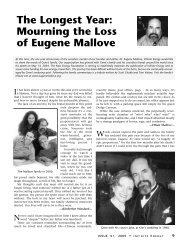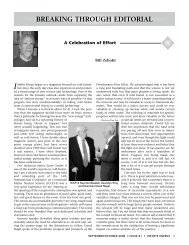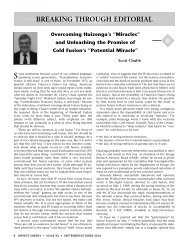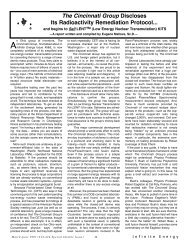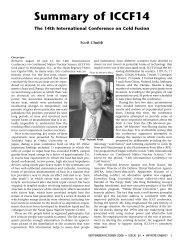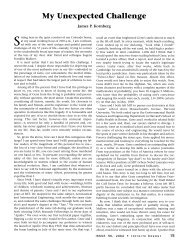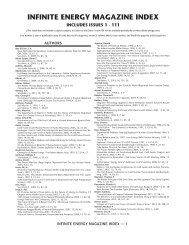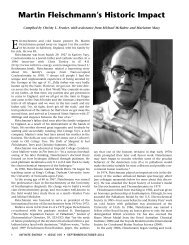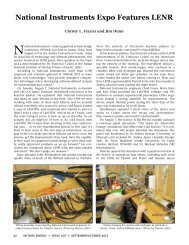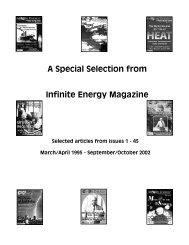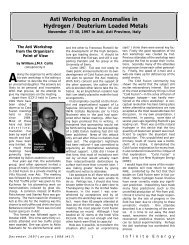MIT and Cold Fusion: A Special Report - Infinite Energy Magazine
MIT and Cold Fusion: A Special Report - Infinite Energy Magazine
MIT and Cold Fusion: A Special Report - Infinite Energy Magazine
Create successful ePaper yourself
Turn your PDF publications into a flip-book with our unique Google optimized e-Paper software.
inexhaustible energy source for the<br />
next century, fusion as it is now being<br />
developed will almost certainly be too<br />
expensive <strong>and</strong> unreliable for commercial<br />
use.”; “The scientific goal of the<br />
fusion program turns out to be an<br />
engineering nightmare.”; “A fusion<br />
reactor might well produce only onetenth<br />
as much power as a fission reactor<br />
of the same size.”; “The drawbacks<br />
Professor Lawrence M. Lidsky of the existing fusion program will<br />
weaken the prospects for other<br />
fusion programs, no matter how<br />
wisely redirected.” Foreshadowing<br />
the benefit of cold fusion that<br />
would emerge over five years<br />
later, Lidsky also wrote of aneutronic<br />
hot fusion: “Neutrons<br />
induce radioactivity <strong>and</strong> damage<br />
reactors. Neutron-free fusion<br />
might provide inexhaustible,<br />
benign power.” Prof. Lidsky later<br />
moved into work at <strong>MIT</strong> on<br />
advanced fission reactors, but<br />
Technology Review October 1983 kept an open mind about cold<br />
Alcator-C hot fusion tokamak reactor at <strong>MIT</strong> Plasma <strong>Fusion</strong> Center. Magnetic<br />
fields confine a hydrogen plasma while the temperature <strong>and</strong> density are<br />
increased. (From <strong>MIT</strong> Plasma <strong>Fusion</strong> Center pamphlet, “<strong>Fusion</strong> <strong>Energy</strong> Research”)<br />
fusion after it emerged.<br />
Enter Fleischmann <strong>and</strong> Pons<br />
Onto the scene on March 23, 1989 came two world-class electrochemists,<br />
Professors Martin Fleischmann <strong>and</strong> Stanley Pons,<br />
who were boldly claiming on international television that they<br />
had already achieved break-even in some form of nuclear<br />
fusion, but in a humble jar of heavy water—without lethal<br />
attendant radiation! This was an instant prescription for controversy.<br />
By analogy, it was as shocking <strong>and</strong> insulting to the hot<br />
fusion people as if they had been told that their television set<br />
had not been able to turn on for decades because they had<br />
neglected to plug it in! The threat to the hot fusion enterprise<br />
was palpable <strong>and</strong> real. More to the point: even if the hot fusion<br />
people did not believe the Utah claims were sound, the threat<br />
that some hot fusion funding (perhaps $25 million) would be<br />
diverted by the U.S. Congress to study cold fusion was very<br />
real. The always financially embattled hot fusion program was<br />
running scared in the onslaught of cold fusion news.<br />
<strong>MIT</strong> Professor Ronald Ballinger, who would play a key role in<br />
the sc<strong>and</strong>alous attacks against cold fusion, testified before the<br />
U.S. House of Representatives’ Committee on Science, Technology,<br />
<strong>and</strong> Space (see Exhibit A). His April 26, 1989 testimony had a<br />
seemingly appropriate “wait <strong>and</strong> see” message, but behind the<br />
scenes Ballinger, Parker, <strong>and</strong> other <strong>MIT</strong> hot fusioneers had<br />
among themselves already dismissed cold fusion. They were<br />
sharpening their knives against Fleischmann <strong>and</strong> Pons. (See<br />
recorded interview with Boston Herald, Exhibit B.)<br />
The idea that deuterium in heavy water might be undergoing<br />
some kind of nuclear fusion reaction within the palladium cathodes<br />
of the Pons-Fleischmann cells was, of course, very difficult<br />
to accept. Where was the expected lethal radiation, for example,<br />
which st<strong>and</strong>ard nuclear physics would seem to predict? Why<br />
weren’t Pons <strong>and</strong> Fleischmann dead if they had truly generated<br />
even a minor fraction of a watt of cold fusion-derived energy?<br />
This became known as “the dead graduate student” problem.<br />
Furthermore, how could the palladium cell have overcome the<br />
natural, very high electric repulsion force between the positively<br />
charged deuterium nuclei—the so-called Coulomb barrier<br />
that had been thought to put an absolute barrier between high<br />
energy nuclear physics <strong>and</strong> ordinary chemistry? Elements<br />
(except those that are radioactive or which spontaneously fission)<br />
should retain their identities. This is basic scientific “fact”<br />
doled out in high school science classes. Room-temperature<br />
fusion of even light elements such as hydrogen or lithium was<br />
considered to be prima facie impossible. (There was an old pre-<br />
Dr. Stanley Luckhardt of the <strong>MIT</strong> Plasma <strong>Fusion</strong> Center poses in<br />
the spring of 1989 with nest of cold fusion cells on a lab cart. Ironically,<br />
this cold fusion equipment was removed from the cavernous<br />
neutron-shielded room to make way for the next generation Alcator-C<br />
hot fusion reactor.<br />
(<strong>MIT</strong> News Office Photo)<br />
7 <strong>Infinite</strong> <strong>Energy</strong> • ISSUE 24, 1999 • <strong>MIT</strong> <strong>Special</strong> <strong>Report</strong><br />
Professors Martin Fleischmann (R) <strong>and</strong> Stanley Pons (L).<br />
<strong>Infinite</strong> <strong>Energy</strong> archives



